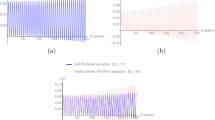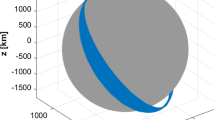Abstract
Satellite orbits around a central body with arbitrary zonal harmonics are considered in a relativistic framework. Our starting point is the relativistic Celestial Mechanics based upon the first post-Newtonian approximation to Einstein’s theory of gravity as it has been formulated by Damour et al. (Phys Rev D 43:3273–3307, 1991; 45:1017–1044, 1992; 47:3124–3135, 1993; 49:618–635, 1994). Since effects of order \((\mathrm{GM}/c^2R) \times J_k\) with \(k \ge 2\) for the Earth are very small (of order \( 7 \times 10^{-10}\,\times \,J_k\)) we consider an axially symmetric body with arbitrary zonal harmonics and a static external gravitational field. In such a field the explicit \(J_k/c^2\)-terms (direct terms) in the equations of motion for the coordinate acceleration of a satellite are treated first with first-order perturbation theory. The derived perturbation theoretical results of first order have been checked by purely numerical integrations of the equations of motion. Additional terms of the same order result from the interaction of the Newtonian \(J_k\)-terms with the post-Newtonian Schwarzschild terms (relativistic terms related to the mass of the central body). These ‘mixed terms’ are treated by means of second-order perturbation theory based on the Lie-series method (Hori–Deprit method). Here we concentrate on the secular drifts of the ascending node \(<\!{\dot{\Omega }}\!>\) and argument of the pericenter \(<\!{\dot{\omega }}\!>\). Finally orders of magnitude are given and discussed.
Similar content being viewed by others
Notes
The dipole \(J_1\) vanishes because of the choice of coordinates (center of mass condition).
Consider that in the Euler–Lagrange equations \(\text {d}/\text {d}t = \partial /\partial t + \mathbf {v}\nabla \), which will lead to terms proportional to \(\dot{\mathbf {v}} = \mathbf {a}\). To derive the direct terms of order \(J_k/c^2\) in (6) we insert \(\mathbf {a}= \nabla w + \mathcal {O}_2\) and neglect terms of order \(c^{-4}\).
Here M is the central bodies mass, not to be confused with the mean anomaly M, meant when defining the Delaunay variables.
Abbreviations
- \(x^\mu = (ct,\mathbf {x})\) :
-
Space-time coordinates
- \(g_{\mu \nu }\) :
-
Space-time metric tensor
- \(\sigma \) :
-
Gravitating mass-energy density
- G :
-
Universal gravitational constant
- \(P_k\) :
-
Ordinary Legendre polynomials
- \(\alpha _{k,j}\) :
-
Coefficients in the derivatives of the Legendre polynomials, see (13)
- \(J_k\) :
-
Dimensionless post-Newtonian zonal harmonic
- \(\left[ {x} \right] \) :
-
Greatest integer that is less than or equal to x (Gauss’ bracket)
- \(X_k^{pq}(e) \) :
-
Hansen coefficient
- \(F_{kpq} (I) \) :
-
Kaula inclination function
- \(\Phi _{i,j,k,p}(f,\omega )\) :
-
Special function defined in (39a)
- \(\Phi ^*_{i,j,k,p}(f,\omega )\) :
-
Special function defined in (39b)
- \(\Psi _{i,j,k,p}(f,M)\) :
-
Special function defined in (39c)
- S, T, W :
-
Decomposition of perturbing acceleration into radial, transversal and normal part
- \((l,g,h; L,G,H) \equiv (\mathbf {y},\mathbf {Y})\) :
-
Post-Newtonian Delaunay variables
- n :
-
Mean motion
- \(b_m\) :
-
Defined below (24)
References
Beutler, G.: Methods of Celestial Mechanics. Springer, Berlin (2005)
Blanchet, L., Damour, T.: Post-Newtonian generation of gravitational waves. Ann. Inst. Henri Poincaré 50, 377–408 (1989)
Brumberg, V.: Relativistic Celestial Mechanics. Nauka, Moscow (1972). In russian
Damour, T., Soffel, M., Xu, C.: General-relativistic celestial mechanics. I. Method and definition of reference systems. Phys. Rev. D 43, 3273–3307 (1991)
Damour, T., Soffel, M., Xu, C.: General-relativistic celestial mechanics. II. Translational equations of motion. Phys. Rev. D 45, 1017–1044 (1992)
Damour, T., Soffel, M., Xu, C.: General-relativistic celestial mechanics. III. Rotational equations of motion. Phys. Rev. D 47, 3124–3135 (1993)
Damour, T., Soffel, M., Xu, C.: General-relativistic celestial mechanics. IV. Theory of satellite motion. Phys. Rev. D 49, 618–635 (1994)
Deprit, A.: Canonical Transformations depending on a small parameter. Celest. Mech. 1, 12–30 (1969)
Garfinkel, B.: The disturbing function for an artificial satellite. Astron. J. 70, 699 (1965)
Hagihara, Y.: Theory of the relativistic trajectories in a gravitational field of Schwarzschild. Jpn. J. Astron. Geophys. 8, 67–176 (1931)
Hairer, E., Nørsett, S.P., Wanner, G.: Solving Ordinary Differential Equations I. Nonstiff Problems. Springer, Berlin (1993)
Hansen, R.: Multipole moments of stationary spacetimes. J. Math. Phys. 15, 46–52 (1974)
Heimberger, J., Soffel, M., Ruder, H.: Relativistic effects in the motion of artificial satellites: the oblateness of the central body II. Celest. Mech. Dyn. Astron. 47, 205–217 (1990)
Hori, G.I.: Theory of general perturbations with unspecified canonical variables. Publ. Astron. Soc. Jpn. 18, 287–296 (1966)
Huang, C., Liu, L.: Analytical solutions to the four post-Newtonian effects in a near earth satellite orbit. Celes. Mech. Dyn. Astron. 53, 293–307 (1992)
Hughes, S.: The computation of tables of Hansen coefficients. Celest. Mech. 29, 101–107 (1981)
Iorio, L.: A critical analysis of a recent test of the Lense–Thirring effect with the LAGEOS satellites. J. Geod. 80, 128–136 (2006)
Iorio, L.: Post-Newtonian direct and mixed orbital effects due to the oblateness of the central body. Int. J. Mod. Phys. D 24, 1550067 (2015)
Kaula, W.M.: Theory of Satellite Geodesy. Blaisdell Publishing Company, Waltham (1966)
Kopeikin, S., Efroimsky, M., Kaplan, G.: Relativistic Celestial Mechanics of the Solar System. Wiley, Weinheim (2011)
Kozai, Y.: The motion of a close earth satellite. Astron. J. 64, 367–377 (1959)
Lucchesi, D., Anselmo, L., Bassan, M., Pardini, C., Peron, R., Pucacco, G., Visco, M.: Testing the gravitational interaction in the field of the Earth via satellite laser ranging and the laser ranged satellites experiment (LARASE). Class. Quant. Grav. 32, 155012 (2015)
Mielnik, B., Plebanski, J.: A study of geodesic motion in the field of Schwarzschild’s solution. Acta Phys. Polonica 21, 239268 (1962)
Milani, A., Nobili, A., Farinella, P.: Non-gravitational Perturbations and Satellite Geodesy. Adam Hilger, Bristol (1987)
Schanner M (2017) Master thesis. unpublished, Dresden
Soffel, M.H.: Relativity in Astrometry, Celestial Mechanics and Geodesy. Springer, Berlin (1989)
Soffel, M., Frutos, F.: On the usefulness of relativistic space-times for the description of the Earth’s gravitational field. J. Geod. 90, 1345–1357 (2016)
Soffel, M., Ruder, H., Schneider, M.: The two-body problem in the (truncated) PPN-theory. Celest. Mech. 40, 77–85 (1987)
Soffel, M., Wirrer, R., Schastok, J., Ruder, H., Schneider, M.: Relativistic effects in the motion of artificial satellites: the oblateness of the central body I. Celest. Mech. 42, 81–89 (1988)
Weinberg, S.: Gravitation and Cosmology: Principles and Applications of the General Theory of Relativity. Wiley, New York (1972)
Author information
Authors and Affiliations
Corresponding author
Ethics declarations
Conflict of interest
The authors confirm that they have no conflict of interest to declare.
Appendices
Appendix
A. Orbital averages
In this paper, certain averages of functions F over one complete revolution in the unperturbed Keplerian orbit are employed:

where M and f are the mean and true anomaly, respectively, \(\eta \equiv \sqrt{1 - e^2}\) and
The following averages are used:


From these relations, the following special cases can be derived:











with
where G and L are Delaunay elements.
B. Solutions for the direct terms
Here, we list the results for all orbital elements. The subscript SP stands for short-periodic, LP for long-periodic and S for secular perturbations. To condense the short-periodic results, we use the functions
Note, that there are poles in the denominator for certain combinations of indices. For the short-periodic solutions these correspond to long-periodic terms and for the long-periodic solutions they correspond to secular drifts, i.e. they have to be excluded from the sums.
1.1 Semi-major axis a
where \(k' = k-2m\text { and }k'' = k-2j-2m~\).
1.2 Eccentricity e
1.3 Inclination I
1.4 Argument of periapsis \(\omega \)
We give the results for \(\omega ' = \omega + \Omega \cos I\). As mentioned above, one has to pay attention to \(\omega \), if one considers only odd multipoles, in which case the lowest odd multipole will not give rise to long-periodic perturbations.
1.5 Longitude of the ascending node \(\Omega \)
1.6 Mean anomaly M
We give results for \(M' = M - n\cdot t + \omega \cdot \eta + \Omega \eta \cos I\). For k odd there are no secular perturbations in the mean anomaly.
C. Expressions in the canonical approach
First, we list two remaining expressions from the calculation process in the canonical approach. From these the (quasi-)Newtonian results for arbitrary \(J_k\) can be reproduced. Finally we list the expressions for the second-order drifts in \(h = \Omega \) and \(g = \omega \).
Since the two Lie-transformations contain the short-periodic and long-periodic perturbations only, the secular drifts in \(h = \Omega \) and \(g = \omega \) are given by the drifts in \(h''\) and \(g''\), respectively. For these we find to second order


and the derivatives, giving the second-order secular drifts, are




The dots-term \(\left( \dots \right) \) denotes the respective part in  (Eq. 30).
(Eq. 30).
Rights and permissions
About this article
Cite this article
Schanner, M., Soffel, M. Relativistic satellite orbits: central body with higher zonal harmonics. Celest Mech Dyn Astr 130, 40 (2018). https://doi.org/10.1007/s10569-018-9836-6
Received:
Revised:
Accepted:
Published:
DOI: https://doi.org/10.1007/s10569-018-9836-6




